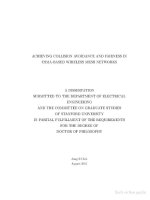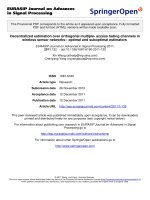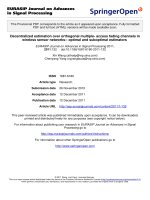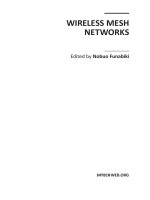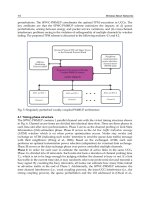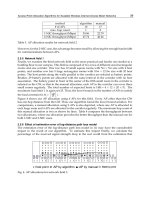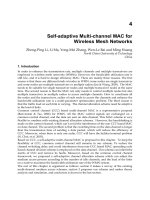Dynamic association in wireless mesh networks
Bạn đang xem bản rút gọn của tài liệu. Xem và tải ngay bản đầy đủ của tài liệu tại đây (576.82 KB, 97 trang )
DYNAMIC ASSOCIATION IN WIRELESS
MESH NETWORKS
Wang Hui
(B.Eng, XJTU )
A THESIS SUBMITTED
FOR THE DEGREE OF MASTER OF ENGINEERING
DEPARTMENT OF ELECTRICAL AND COMPUTER ENGINEERING
NATIONAL UNIVERSITY OF SINGAPORE
2010
2
Acknowledgements
First of all, I would like to thank my supervisors, Prof. Lawrence W. C.
WONG, Dr. SOH Wee Seng and Dr. Mehul MOTANI for their invaluable guidance,
generous advice and unwavering patience throughout my research. This thesis will
not be possible without their continuous support.
I would also like to express my appreciation to my parents and the whole
family. It is them that give me endless love and encouragement throughout my
life.
Also to all the staff and students in Ambient Intelligence Lab and Communications Lab and all my friends. Their precious friendship and encouragement have
put me through many tough times.
Finally, I am grateful for the partial support from Interactive and Digital
Media Institute, which was approved by my supervisors.
i
ACKNOWLEDGEMENTS
ii
Contents
Acknowledgements
i
Contents
ii
Summary
vi
List of Figures
x
List of Tables
xiii
List of Symbols
xiv
1 Introduction
1
1.1
Wireless Networks
. . . . . . . . . . . . . . . . . . . . . . . . . . .
1
1.2
Association Mechanisms . . . . . . . . . . . . . . . . . . . . . . . .
3
1.3
Thesis Overview . . . . . . . . . . . . . . . . . . . . . . . . . . . . .
3
2 Wireless Mesh Networks
7
2.1
Introduction . . . . . . . . . . . . . . . . . . . . . . . . . . . . . . .
7
2.2
Characteristics of Wireless Mesh Networks . . . . . . . . . . . . . .
8
2.2.1
8
Network Architecture . . . . . . . . . . . . . . . . . . . . . .
iii
CONTENTS
2.2.2
Typical Features . . . . . . . . . . . . . . . . . . . . . . . .
11
2.2.3
Application Scenarios . . . . . . . . . . . . . . . . . . . . . .
12
2.3
Issues and Challenges . . . . . . . . . . . . . . . . . . . . . . . . . .
14
2.4
Standard Activities . . . . . . . . . . . . . . . . . . . . . . . . . . .
17
2.4.1
IEEE 802.11s . . . . . . . . . . . . . . . . . . . . . . . . . .
17
2.4.2
Other Standards for Wireless Mesh Networks . . . . . . . .
18
Real Deployments . . . . . . . . . . . . . . . . . . . . . . . . . . . .
20
2.5
3 Association Mechanisms in Wireless Networks
21
3.1
Association Procedure in IEEE 802.11 Specifications . . . . . . . .
21
3.2
Association Mechanisms Already Proposed . . . . . . . . . . . . . .
22
3.3
Association Game in Wireless Networks . . . . . . . . . . . . . . . .
23
4 Factors Considered in the Association in Wireless Mesh Networks 25
4.1
Association Mechanisms in WMNs Proposed Previously . . . . . . .
25
4.2
Link Quality . . . . . . . . . . . . . . . . . . . . . . . . . . . . . . .
26
4.3
Load Balancing . . . . . . . . . . . . . . . . . . . . . . . . . . . . .
27
4.4
Cross-layer Association . . . . . . . . . . . . . . . . . . . . . . . . .
28
4.5
Reflecting Dynamic Network Conditions . . . . . . . . . . . . . . .
29
4.6
Association Time Overhead . . . . . . . . . . . . . . . . . . . . . .
30
4.7
Accelerate Network Convergence Speed - Association Oscillation
4.8
Avoidance . . . . . . . . . . . . . . . . . . . . . . . . . . . . . . . .
31
Conclusion . . . . . . . . . . . . . . . . . . . . . . . . . . . . . . . .
31
5 Dynamic Association in 802.11 Based Wireless Mesh Networks
5.1
System Model . . . . . . . . . . . . . . . . . . . . . . . . . . . . . .
iv
33
33
CONTENTS
5.2
Framework of Dynamic Association Mechanism . . . . . . . . . . .
35
5.3
Elaboration of Dynamic Association Mechanism . . . . . . . . . . .
36
5.3.1
Association Cost of the Access Link . . . . . . . . . . . . . .
36
5.3.2
Association Cost of the Multi-hop Wireless Backbone . . . .
39
5.3.3
Procedure of Dynamic Association Mechanism . . . . . . . .
40
5.3.4
Dynamic Re-association, Association Oscillation Avoidance
5.4
5.5
and Network Convergence . . . . . . . . . . . . . . . . . . .
42
Basic Analysis of Dynamic Association Mechanism . . . . . . . . .
43
5.4.1
New Aspects of Dynamic Association . . . . . . . . . . . . .
43
5.4.2
Basic Analysis . . . . . . . . . . . . . . . . . . . . . . . . . .
44
Conclusion . . . . . . . . . . . . . . . . . . . . . . . . . . . . . . . .
47
6 Evaluation of the Dynamic Association Mechanism
49
6.1
Introduction of Network Simulation Tools . . . . . . . . . . . . . .
49
6.2
Performance of the Association Mechanism . . . . . . . . . . . . . .
52
6.3
Dynamic Re-association versus Static Association . . . . . . . . . .
58
6.4
Oscillation Avoidance . . . . . . . . . . . . . . . . . . . . . . . . . .
60
6.5
Network Convergence . . . . . . . . . . . . . . . . . . . . . . . . . .
66
6.6
Conclusion . . . . . . . . . . . . . . . . . . . . . . . . . . . . . . . .
67
7 Conclusion and Future Work
69
A List of Publications
73
Bibliography
75
v
SUMMARY
vi
Summary
Nowadays, network communications with end devices are increasingly wireless.
IEEE 802.11 based wireless local area networks (WLANs) and cellular network
based mobile phones are widely used in our everyday life. With increasing demand for multimedia transmission and unrestrained roam, all the existing wireless
networks should be updated. Hence, many standards for wireless networking are
now taking the next step to support mesh architectures in which data is commonly
forwarded on paths consisting of multiple wireless hops. Wireless mesh networks
(WMNs) are one of these new technologies which support higher link capacity and
wider wireless network coverage.
As a promising next generation wireless networking technology, WMNs have
been attracting considerable research and industrial focus, and they are undergoing
rapid progress and inspiring numerous applications. All unique characteristics and
advantages of WMNs owe to the multi-hop wireless mesh backbone, which is formed
through the self-organization of mesh routers. Mesh end stations (STAs) should
associate with mesh access points (MAPs) to obtain network access and be part
of the network. STAs can roam freely over the wireless network coverage area
by handoff among MAPs nearby. Furthermore, WMNs can be integrated with
other types of networks, such as Internet, Wi-Fi, WiMax, cellular networks and so
vii
SUMMARY
on, with gateway functionalities in some of the MAPs. This unique architecture
brings in many advantages to WMNs. Thanks to the multi-hop wireless backbone,
WMNs enable rapid deployment with lower cost backhaul, self-healing, resilience
and good scalability. Also, WMNs support widespread wireless network coverage
due to multi-hop forwarding, higher bandwidth due to shorter hops, better battery
life in end devices (e.g., STAs) due to lower power transmission.
In order to enable these unique characteristics and advantages of WMNs, many
issues and challenges should be solved. Many conventional management mechanisms which have significant effect on network performance should also be reconsidered. Such a mechanism is the association of STAs with MAPs of the wireless
backbone. Previous standards and literatures have already devised many association mechanisms in wireless networks. IEEE 802.11 specifications define a simple
Received Signal Strength Indication (RSSI) based association mechanism, in which
STAs simply select the access point (AP) with the highest RSSI value to associate
with. Other literatures either highlight link quality or load balancing solely or make
some impractical assumptions. Several works on association mechanisms in WMNs
propose a cross-layer framework considering jointly the association cost of access
links and cost of the multi-hop wireless backbone, which suits well in WMNs.
Based on the cross-layer association framework, we propose a dynamic association mechanism in the context of IEEE 802.11 based WMNs. Our dynamic
association mechanism takes wireless link quality, load balancing and association
oscillation avoidance into consideration. The metric introduced in this association
mechanism measures the real traffic load through channel based load detection
and suits both coordinated and uncoordinated networks. Because of the random
characteristics of wireless links and the variability of network conditions, we inviii
SUMMARY
troduce oscillation avoidance schemes, which consist of periodic STA scan and
re-association threshold. We further evaluate our dynamic association mechanism
through elaborate simulation, which shows that the proposed dynamic association
mechanism outperforms other association mechanisms and improve network performance significantly. Furthermore, our mechanism can accelerate the convergence
speed of WMNs. The simulation additionally shows there exists optimal values
for both re-association threshold and STA scan period, corresponding to specific
network scenarios (e.g., network topology, scale, traffic load, etc.).
Our dynamic association mechanism characterizes the dynamic network scenarios in real time, hence improve network performances significantly. But there
are still some further work to do in order to perfect our association mechanism, as
will be elaborated in the last chapter of future work.
ix
SUMMARY
x
List of Figures
1.1
Taxonomy of wireless networks. . . . . . . . . . . . . . . . . . . . .
2
2.1
Infrastructure/Backbone wireless mesh networks. . . . . . . . . . .
9
2.2
Hybrid wireless mesh networks. . . . . . . . . . . . . . . . . . . . .
10
5.1
System model for association in 802.11 based WMNs. . . . . . . . .
34
5.2
Association in uncoordinated wireless mesh networks. . . . . . . . .
46
6.1
Schematic of a mobilenode under the CMU monarch’s wireless extensions to ns. . . . . . . . . . . . . . . . . . . . . . . . . . . . . . .
50
6.2
Modified mobile node architecture supporting multiple interfaces. .
51
6.3
One of the random topologies of the Wireless Mesh Networks for
performance evaluation. . . . . . . . . . . . . . . . . . . . . . . . .
53
6.4
Channel based load detection versus cell based load detection. . . .
54
6.5
Basic performance evaluation with 8 cross flows. . . . . . . . . . . .
57
6.6
Basic performance evaluation with 8 edge flows. . . . . . . . . . . .
58
6.7
Basic performance evaluation with 8 parellel flows.
. . . . . . . . .
58
6.8
Dynamic re-association versus static association. . . . . . . . . . . .
61
6.9
Oscillation avoidance. . . . . . . . . . . . . . . . . . . . . . . . . . .
63
xi
LIST OF FIGURES
6.10 Varying re-association threshold.
. . . . . . . . . . . . . . . . . . .
65
6.11 Varying STA scan period. . . . . . . . . . . . . . . . . . . . . . . .
66
6.12 Network convergence speed. . . . . . . . . . . . . . . . . . . . . . .
68
xii
List of Tables
1.1
Wireless Network Standards. . . . . . . . . . . . . . . . . . . . . . .
xiii
1
List of Symbols
xiv
List of Symbols
Symbol
Description
WPANs
Wireless Personal Area Networks
WLANs
Wireless Local Area Networks
WMANs
Wireless Metropolitan Area Networks
WWANs
Wireless Wide Area Networks
WMNs
Wireless Mesh Networks
WSNs
Wireless Sensor Networks
STAs
End Stations
APs
Access Points
MAPs
Mesh Access Points (equipped with access interfaces and relay interfaces)
MPs
Mesh Points (equipped with relay interfaces)
Wi-Fi
Trademark of Wi-Fi Alliance, which is based on the IEEE 802.11 standards
WiMax
Worldwide Interoperability for Microwave Access, trademark of WiMax forum, w
Bluetooth
wireless technology based on the IEEE 802.15.1 standard for WPANs
ZigBee
wireless technology based on the IEEE 802.15.4 standard for WPANs
GSM
Global System for Mobile communications
GPRS
General Packet Radio Service
xv
List of Symbols
DSL
Digital Subscriber Line
RSSI
Received Signal Strength Indication
ns-2
network simulator version 2
GT-ITM
Georgia Tech Internetwork Topology Models
FHSS
Frequency Hopping Spread Spectrum
OFDM
Orthogonal Frequency Division Multiplexing
UWB
Ultra-Wide Band
MIMO
Multiple-Input and Multiple-Output
MAC
Multiple Access Control
HWMP
Hybrid Wireless Mesh routing Protocol
TCP
Transmission Control Protocol
TDMA
Time Division Multiple Access
SSs
Subscriber Stations
PMP
Point-to-Multipoint
MBWA
Mobile Broadband Wireless Access
BER
Bit Error Rate
SINR
Signal Interference Noise Ratio
SNR
Signal Noise Ratio
DBPSK
Differential Binary Phase Shift Keying
DQPSK
Differential Quadrature Phase Shift Keying
CCK
Complementary Code Keying
LAETT
Load Aware Expected Transmission Time
GAB
Global Association information Base
LAB
Local Association information Base
PER
Packet Error Rate
xvi
List of Symbols
CBR
Constant Bit Rate
ATTBW
Attainable Bandwidth
VoIP
Voice over Internet Protocol
W MNs
ACa,i
the total association cost of STA i if associated with MAP a in WMNs
ACa,i
the association cost of the access link between STA i and MAP a
RCaBackbone
the association cost of the backbone route from MAP a to the destination STA
xvii
List of Symbols
xviii
Chapter 1
Introduction
1.1
Wireless Networks
Network communication with end devices is increasingly wireless. From wireless wide area networks (WWAN), wireless metropolitan area networks (WMANs)
and wireless local area networks (WLANs) to wireless personal area networks
(WPANs), many standards have been proposed as shown in Table 1.1. Many
industrial alliances and forums are also established, such as WiMAX [1], Wi-Fi [2],
[3], Bluetooth [4] and ZigBee [5], to promote the commercial application of all the
proposed wireless technologies.
Table 1.1: Wireless Network Standards.
Wireless
Wireless
Wireless
Wireless
Wireless
Networks
Wide Area Networks (WWANs)
Metropolitan Area Networks (WMAN)
Local Area Networks (WLANs)
Personal Area Networks (WPANs)
1
Standards
GSM, GPRS, 3G
IEEE 802.16
IEEE 802.11
IEEE 802.15.1, IEEE 802.15.4
CHAPTER 1. Introduction
Actually, the most general form of wireless networks are ad-hoc networks.
There are no constraints on network topology, node roles and services. In adhoc networks, all nodes can move freely and all nodes are peers to each other.
It is extraordinarily complex in this general form due to its lack of constraints.
Hence many prerequisites and assumptions are introduced to simplify the study
and real application of this general wireless networks. All other wireless networks in
some sense could be considered as the specific examples and particular application
oriented scenarios, which involves wireless sensor networks, commercial applications
of wireless standards (e.g., Wi-Fi, cellular networks). While most of the wireless
technologies applied widely today involve only one hop wireless links (connecting
to traditional wired networks) such as Wi-Fi, cellular networks and Bluetooth,
multi-hop wireless networks are studied more and more due to their attractive
advantages. Therefore, wireless mesh networks (WMNs) [6], [7], [8], a simplified
form of ad-hoc networks, are emerging as a promising wireless network technology
which is attracting numerous academia and industrial interest. All these wireless
networks can be categorized according to their unique characteristics as in Fig. 1.1.
Infrastructure-based
802.11
Cellular Networks
802.16
Single Hop
Infrastructure-less
802.11
ZigBee
Bluetooth
Wireless Networking
Infrastructure-based
Wireless Mesh Networks
Multi-hop
Wireless Sensor Networks
Infrastructure-less
(MANET)
ZigBee
Fig. 1.1: Taxonomy of wireless networks.
2
CHAPTER 1. Introduction
1.2
Association Mechanisms
To date, the most broadly deployed wireless networks are wireless local area
networks (WLANs), except cellular networks. IEEE 802.11 WLANs are deployed
widely in campuses, communities and other public areas. In this kind of WLANs,
there exist two kinds of nodes, access points (APs) and end stations (STAs). STAs
must associate with APs, which are connected to the Internet directly using wired
cables, to obtain network access. Because STAs’ traffic communications must go
through APs, the association mechanism which is responsible for choosing APs is
very important in WLANs. WMNs also involve association mechanisms for STAs
to choose mesh access points (MAPs). Similarly, association mechanisms are also
significant in WMNs.
1.3
Thesis Overview
In this thesis, we propose a dynamic association mechanism in WMNs that
takes load balancing, link quality and association oscillation avoidance into consideration. The metric introduced in this association mechanism measures the real
traffic load through channel based load detection and suits both coordinated and
uncoordinated networks. Because of the random characteristics of wireless links
and the variability of network conditions such as node mobility and traffic requirements, dynamic re-association should be involved. To avoid association oscillation
during re-association, we introduce oscillation avoidance schemes, which consist of
periodic STA scan and re-association threshold. The performance of this dynamic
association mechanism is evaluated in the context of 802.11 based wireless mesh
networks.
3
CHAPTER 1. Introduction
The rest of this thesis is organized as follows. In chapter 2, WMNs are introduced, which covers network architecture, typical features, application scenarios
and advantages of WMNs. Of course, there exist limitations and challenges in
WMNs. These should also be mentioned. Nowadays, many existing standards are
revisited to extend support for mesh functionalities. This brings out many new
specifications, such as IEEE 802.11s and mesh in 802.16. Furthermore, some cities
over the world have deployed real WMNs, which validate the advantage and feasible
of WMNs.
Association mechanisms in wireless networks, especially in WLANs, are presented in chapter 3. The classic association mechanism in the IEEE 802.11 specification is based on received signal strength indication (RSSI). STAs simply choose
the APs with the highest RSSI to associate with, which is simple but non-optimal.
Therefore, there has been increasing interest in this topic and many new association mechanisms are designed. Furthermore, the association procedure is modeled
as an association game in some literature to find the theoretical optimal solutions.
The association mechanisms in WMNs are introduced in chapter 4. To improve the performance of WMNs, many factors should be considered during the
association procedure. Wireless link quality, load balancing, cross-layer association, association time overhead, how to reflect dynamic network conditions and
accelerating network convergence speed are analyzed here.
Chapter 5 elaborates on our proposed association mechanism in 802.11 based
wireless mesh networks. To explain our mechanism, the system model where our association mechanism is applied is introduced first. Because our mechanism is based
on a cross-layer framework, the association costs of the access link and multi-hop
wireless backbone are described respectively then. Finally, the detailed procedure
4
CHAPTER 1. Introduction
and important factors we take into account are specified.
To validate the advantages of our association mechanism, we evaluate it in
chapter 6. Network simulator ns 2 and topology generator GT-ITM are used together as the evaluation tool. We have carried out a series of experiments to verify
the performance comprehensively, which involves performance of the basic association mechanism, dynamic re-association, oscillation avoidance schemes and network
convergence speed and so on. We obtain convincing results from these experiments
and are confident that our mechanism outperforms other existing mechanisms in
WMNs.
Chapter 7 states the conclusion and future work.
5


